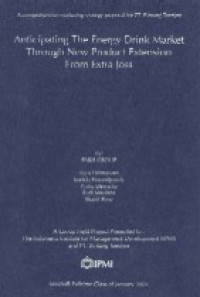
Economic Pre-Feasibility on Processing Monazite as By-Product Mineral from Tin Mining at PT Koba Tin
| Gmd : Text
| Availability :
| 00000011480 | 413 | (GFP) | Available - Ada |
Group Field Project (GFP) is one of the requirements for obtaining the Master Degree at IPMI. Our GFP focuses on pre-feasibility study of processing monazite into Rare Earth Element (REE). Our aim is to provide an alternative business for PT Koba Tin (PTKT) in extracting by product mineral Monazite into REE with higher value added.
PTKT presently operates under a Contract of Work (CoW) with the Indonesian government for a total area of 41,680. The CoW will be expired by 2013 and verbally will be granted for additional 10 years extension under IUP (Ijin Usaha Pertambangan - Business Mining License). However, under IUP mining concession will be limited into maximum 25,000 Ha which is estimated to produce around 150,000 to 180,000 M3 ore (source: interview with various stakeholders). Such resource will worth of refined tin of 35,000 to 50,000 tons. With lower production volume expected, PTKT is pressed to find alternative source of income to remain profitable.
Assuming the average price will go around USD 22,000 per metric tons thus it will give PTKT potential revenue of USD 77 Million -110 Million pa. With the total cost at 2009 of USD 88.6 Million, it would be hard for PTKT to maintain the healthy financial performance.
From its tin mining activities, PTKT has a stockpile of 4,614 tons monazite that can be further processed to produce Rare Earth Elements (REE).
Through the XRF (X-Ray Fluorescence Spectrometer) result shows that monazite at PTKT contains Cerium, Lanthanum and Neodymium in higher proportion. These three minerals are expected to enjoy growing market consumption, surpassing the supply, triggered primarily by China's decision to cut its exports to fulfill its own needs for rare earth.
Our analysis, which cover industry analysis, industry benchmarking and pre-feasibility study, concluded the feasibility of monazite processing as a potential new business for PTKT. Details of feasibility study currently has good selling price and tend to hike from time to time.
REE Supply and Demand With combined factors of China RE Exportation reduction, increasing demand on China's domestic and the soaring world consumption of RE's product have impacted to shortfall of supply. The shortage of supply compared to demand in 2015 will achieve 40,000 tons. In addition, if China continues to reduce export quotas and bans the export of a number of rare earths, the gap could be even larger. This condition is reflected by movement of selling price that dramatically jump up in 2010.
Industry Analysis Based on Five Forces analysis developed by Michael Porter the Rare Earth Processing Industry is currently attractive. It indicates that the existing players are enjoying healthy margin. Four factors are showing weak or insignificant, they are: threat of entrance, bargaining power of buyer, rivalry amongst existing player and threat of substitution. Bargaining Power of supplier is classified as medium due to strong presence of ore suppliers to RE processing, while it is balanced out by weak presence of reagent and machinery supplier.
In general, the industry outlook is promising as it is predicted the demand still outstrip the supply even in the next 5 -10 years.
Project Benchmark
Out of several projects, we took 3 projects as benchmark to compare with our proposed one. The benchmark is taken from projects Kvanefjeld, Greenland; Bear Lodge, US and Strange Lake, Canada. From the economic benchmark we concluded 3 main parameters namely IRR in the range of 24 -47%, productivity value (NPV divided by weight output) 2.46 -15.09% and payback period is 3 years 1 month up to 6 years. These benchmarks are calculated based on pre-tax income and hurdle rate 10%.
With the same calculation based, the proposed project for PTKT generates 44% IRR, 15.37% productivity value and 2 years 10 months payback period. Numbers clearly show project are close in the highest range of each parameter.
Pre-Feasibility Study
The Pre-Feasibility study is conducted by taking input of 1,000 tons monazite ore that will yield into 88.65 TREO per year.
By using interpolation ratio from BATAN and various studies we can derive economic pre-feasibility as summarized below:
Total Initial Cost : IDR 53,629 billion per project
Total Revenue : IDR 133,947 million per annum
Total Cost : IDR 104,176 million per annum
Net present value : IDR 56,959 million
Internal Rate of Return : 33%
Payback period : 4 years 3 months
To see the impact of investment when parameter changes, the sensitivity analysis is assessed with various scenarios:
*Selling price of REO decline by 10%
* Reagent price increases by 10%
* License Fee goes up by 10% and export tax moves up 5% .Monazite sand purchased from market
The result still shown very promising with lowest IRR 21 %. longest payback period 6 years 5 months and lowest NPV illR 20.1 billion.
Based on financial projection and sensitivity analysis above we can conclude that business is feasible. Thus we highly recommend that PTKT should continue the project.
Research Location : PT. Koba Tin
Read at Library Only.
| Series Title |
-
|
|---|---|
| Call Number |
413
|
| Publisher Place | Jakarta |
| Collation |
xviii, 135p.: col.ill.; appendixes ; 30cm. + CD
|
| Language |
English
|
| ISBN/ISSN |
-
|
| Classification |
-
|
| Media Type |
-
|
|---|---|
| Carrier Type |
-
|
| Edition |
-
|
| Subject(s) | |
| Specific Info |
-
|
| Statement |
-
|
| Content Type |
-
|
No other version available







